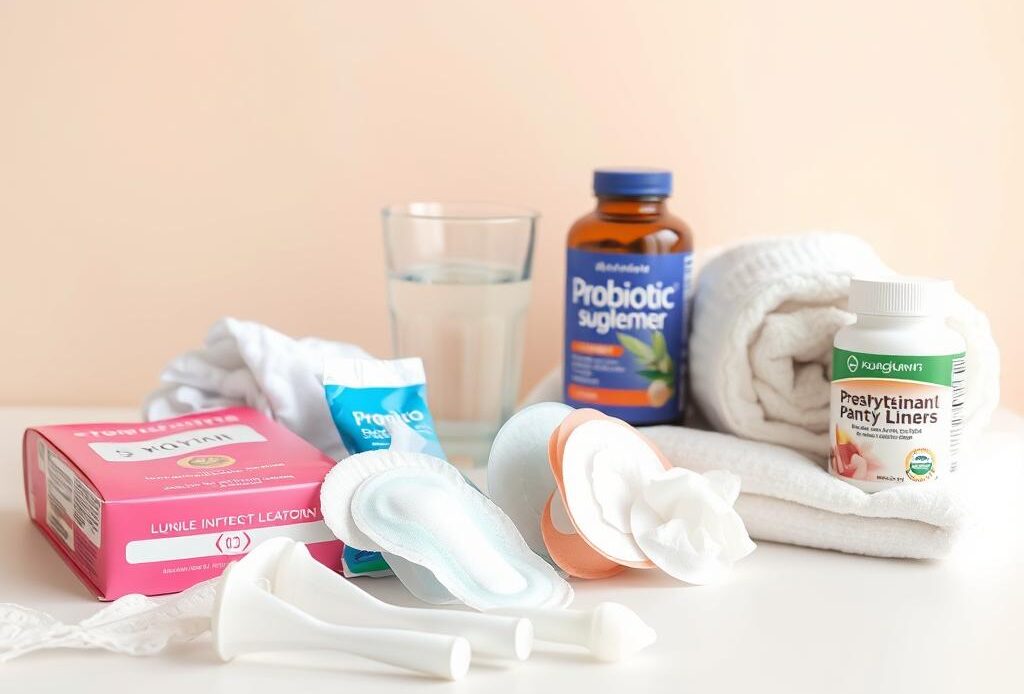
Many people experience unexpected discomfort after using personal items during private moments. This often stems from an imbalance in natural microorganisms, which health experts link to overgrowth of a common fungus. While these issues aren’t contagious, certain activities can create environments where imbalances thrive.
Sharing or improperly cleaning devices designed for intimacy might contribute to recurring problems. We want to emphasize that simple hygiene habits can significantly reduce risks. Cleaning products thoroughly and storing them properly helps maintain their safety.
Our goal is to provide clear, practical advice for those seeking to enjoy their personal lives without worry. In the following sections, we’ll share science-backed strategies to help you stay comfortable and confident. Let’s explore how small changes can lead to big improvements!
Key Takeaways
- Hygiene practices directly impact the likelihood of developing fungal imbalances
- Proper cleaning methods for personal items are essential for prevention
- These conditions aren’t sexually transmitted but can be influenced by activity
- Moisture control plays a crucial role in maintaining healthy environments
- Early recognition of symptoms leads to quicker resolution
Understanding Yeast Infections
Our bodies naturally maintain a delicate balance of microorganisms, but sometimes this harmony gets disrupted. When certain fungi outgrow their typical levels, uncomfortable symptoms can emerge. Let’s explore why this happens and how to recognize the signs early.
Causes and Triggers
Several factors can tip the scales toward imbalance. Antibiotics often play a role by reducing helpful bacteria that normally keep fungi in check. Hormonal shifts from birth control or pregnancy also create favorable conditions for overgrowth.
Daily habits matter more than many realize. Staying in damp clothes after workouts or swimming traps moisture, creating ideal environments for fungal growth. Even stress weakens immune responses, making it harder for the body to regulate itself.
| Factor Type | Examples |
|---|---|
| Common Causes | Antibiotics, hormonal changes |
| External Triggers | Moisture retention, synthetic fabrics |
Common Symptoms
Recognizing early signs helps address issues quickly. Many experience persistent itching or redness in sensitive areas. A thick, odorless discharge resembling cottage cheese often appears during active flare-ups.
Discomfort during urination or intimacy may also develop. While symptoms vary, noticing these patterns allows for timely action. Simple adjustments to hygiene routines often make a significant difference.
Sex and Yeast Infections: Causes and Connections
Understanding the relationship between intimacy and physical wellness helps us make informed choices. While these conditions aren’t contagious, certain shared activities can temporarily shift delicate biological balances. This makes awareness of bodily responses crucial for maintaining comfort.
How Sexual Activity Influences Imbalances
Physical closeness sometimes introduces new microorganisms to the vagina. Friction during contact may also disturb protective mucus layers, creating opportunities for unwanted bacterial shifts. Research shows that using barrier protection like condoms helps maintain a balanced vaginal environment by reducing pH fluctuations.
Identifying Risk Factors in Relationships
Couples often share more than emotions – they exchange microscopic ecosystems too. If one partner has inconsistent hygiene habits, it might lead to recurring symptoms for both individuals. Common triggers include:
- Unprotected contact during active flare-ups
- Shared towels or clothing
- Delayed post-activity cleansing
Open communication helps partners address these factors effectively. As one health advisor notes:
“Prevention becomes simpler when both people understand their shared role in maintaining wellness.”
| Risk Factor | Prevention Tip |
|---|---|
| Bacterial transfer | Shower before/after intimacy |
| pH imbalance | Choose pH-neutral cleansers |
Monitoring bodily signals allows early intervention. Mild itching or unusual discharge often indicates it’s time to pause activities and consult a healthcare provider.
Preventing Yeast Infections: Best Practices for Health
Maintaining comfort starts with simple daily choices that support your body’s natural defenses. Small adjustments to routines can create environments where wellness thrives, helping prevent common disruptions. Let’s explore practical strategies that work with your body’s needs rather than against them.

Daily Habits for Balanced Wellness
Cleanliness plays a starring role in prevention. Rinsing with warm water and fragrance-free soap after sweating keeps sensitive areas balanced. For women, swapping synthetic underwear for breathable cotton reduces moisture buildup – a key factor in avoiding irritation.
Hydration and diet matter more than you might think. Drinking enough water supports overall health by flushing toxins and maintaining mucous membrane integrity. Pair this with probiotic-rich foods like yogurt to reinforce your body’s microbial harmony.
When it comes to relationships, both partners benefit from consistent hygiene practices. Showering before intimate moments and avoiding shared towels prevents bacterial transfers. As one gynecologist notes:
“Preventive care becomes effortless when couples view it as teamwork rather than a solo effort.”
Proactive steps for women include:
- Choosing pH-balanced cleansers over perfumed products
- Changing out of damp clothing immediately after exercise
- Scheduling regular check-ins with healthcare providers
Open communication between partners about comfort levels helps catch early signs of irritation. Remember – prevention isn’t about restriction, but creating sustainable habits that let you feel your best every day.
Understanding sex toys yeast infections
Personal wellness tools require careful maintenance to prevent unintended health issues. Items designed for private enjoyment can sometimes create environments where microbial imbalances thrive if not properly cared for. Let’s examine how these devices might contribute to intimate health challenges and what you can do to stay protected.
Role of Shared Items in Microbial Transfer
When personal devices aren’t cleaned thoroughly, they become breeding grounds for microorganisms. Studies show that 34% of users who share these items without proper sanitation experience recurring vaginal yeast infections. Residual bodily fluids and moisture create ideal conditions for fungal overgrowth.
Contaminated devices can mimic patterns seen with sexually transmitted infections, even though these conditions aren’t contagious. Partners passing items back and forth without disinfection risk transferring organisms that cause yeast infection flare-ups. As one microbiologist explains:
“Organic residue on shared devices acts like a microbial handshake between users.”
Key factors influencing risk include:
- Material porosity (nonporous surfaces clean easier)
- Frequency of use
- Storage conditions
| Risk Factor | Prevention Strategy |
|---|---|
| Shared use | Disinfect with alcohol-based solutions |
| Moisture retention | Dry completely before storage |
Understanding these connections helps create safer routines. Simple adjustments like using dedicated cleaning brushes or storing devices in breathable pouches make significant differences. Prioritizing hygiene transforms potential risks into confident, worry-free experiences.
Hygiene and Safe Use of Sex Toys
Smart maintenance transforms personal enjoyment into worry-free experiences. Proper care routines ensure your favorite items remain both functional and safe for repeated use. Let’s explore how simple habits can protect your wellness while preserving device quality.
Cleaning and Disinfecting Essentials
Thorough sanitation starts immediately after use. Warm water with mild, fragrance-free soap works well for most materials. For extra protection, alcohol-based sprays eliminate 99% of microorganisms on nonporous surfaces.
Specialized cleaners designed for intimate devices offer pH-balanced formulas. These products prevent chemical residue that might disrupt natural balances. Always dry items completely with clean towels before storage to avoid moisture traps.
Choosing the Right Materials
Device composition dramatically impacts cleanliness. Nonporous options like medical-grade silicone resist bacterial growth and withstand rigorous cleaning. Porous materials like rubber require extra precautions – using protective barriers becomes a good idea here.
| Material Type | Cleaning Difficulty | Safety Tip |
|---|---|---|
| Silicone (Nonporous) | Easy | Boil for 3 minutes |
| Rubber (Porous) | Challenging | Use disposable covers |
Experts recommend replacing porous items every 3-6 months. As one microbiologist notes:
“Material choice directly influences infection risks – nonporous surfaces give users control over microbial management.”
These practices not only prevent vaginal yeast imbalances but extend device lifespan. Pairing smart material choices with consistent cleaning routines creates safer experiences for everyone involved.
Addressing Yeast Infection Symptoms during Intimacy
When physical closeness causes discomfort, it’s time to pause and reassess. Symptoms like irritation or unusual discharge often signal underlying imbalances that need attention. Bacterial vaginosis and similar conditions sometimes mimic yeast-related issues, making accurate identification crucial for effective care.

Managing Discomfort and Irritation
Water-based lubricants reduce friction during sensitive moments. Avoid products with glycerin or fragrances, as these can increase risk of further irritation. Opt for breathable cotton underwear to help skin recover faster.
Overlapping symptoms between bacterial vaginosis and yeast-related issues often confuse people. While both cause discomfort, bacterial imbalances typically produce a fishy odor and thin discharge. Proper diagnosis helps prevent incorrect treatments that might worsen conditions.
“Persistent symptoms require professional evaluation to rule out transmitted infections,” advises Dr. Lisa Morgan, a women’s health specialist.
Key strategies when symptoms flare:
- Pause intimate activities until treatment reduces inflammation
- Use pH-neutral wipes for quick cleanups
- Track symptom patterns to share with healthcare providers
| Condition | Key Differentiator |
|---|---|
| Yeast-related | Thick, odorless discharge |
| Bacterial vaginosis | Fishy smell, thin texture |
Timely action prevents minor issues from becoming recurrent problems. If discomfort persists beyond three days, consult a doctor to confirm whether bacterial imbalances or transmitted infections need specific treatments. Remember – listening to your body’s signals helps maintain both physical comfort and relationship harmony.
Treatment Options and When to See a Doctor
When discomfort arises, knowing your options brings peace of mind. Modern solutions range from pharmacy shelves to doctor’s offices, offering multiple paths to relief. Let’s explore effective strategies to address symptoms while protecting your wellness.
Over-the-Counter and Prescription Treatments
Antifungal creams like clotrimazole provide quick relief for mild cases. These over-the-counter options typically clear symptoms within 3-7 days. For persistent issues, healthcare providers may prescribe oral medications like fluconazole.
Watch for warning signs requiring professional care:
- Recurring symptoms within two months
- Unusual discharge color or odor
- Fever accompanying discomfort
“Self-treatment works best when started early,” notes nurse practitioner Sarah Lin. “But recurring patterns often signal deeper imbalances needing medical insight.”
Home Remedies and Care Practices
Warm baths with colloidal oatmeal soothe irritated skin naturally. Pair these with breathable cotton clothing to support healing. For personal items like vibrators, use alcohol wipes after each use to prevent microbial buildup.
Key maintenance tips for shared devices:
| Material | Cleaning Method |
|---|---|
| Silicone | Boil for 5 minutes |
| Plastic | Disinfectant spray |
While these methods help manage symptoms, remember that sexually transmitted conditions require different approaches. If home care doesn’t improve discomfort within a week, schedule a clinic visit. Proper diagnosis ensures you’re treating the right issue while keeping your personal items safe for future use.
Discussing Yeast Infections with Your Partner
Open dialogue strengthens relationships and protects wellness during sensitive health moments. When symptoms arise, sharing concerns with your partner becomes essential for maintaining trust and comfort. Approach these conversations with care – focus on mutual well-being rather than assigning blame.
Effective Communication Tips
Start by framing the discussion around shared goals. Try saying, “I want us both to feel our best,” instead of focusing on discomfort. This creates teamwork energy. Mention any doctor recommendations clearly – if they suggest temporary changes to intimacy, explain why this matters for recovery.
When using products like condoms or lube, discuss options that support balance. Water-based formulas often cause less irritation during flare-ups. Keep unopened backups handy to avoid last-minute compromises that might worsen symptoms.
If a doctor advises pausing physical closeness, present this as a short-term wellness investment. Suggest alternative ways to maintain connection, like massage or shared hobbies. As one nurse practitioner advises:
“Couples who tackle health challenges together often emerge with stronger bonds.”
Clear communication also helps prevent misunderstandings about STIs. While these conditions aren’t contagious, partners appreciate transparency. Regularly check in about comfort levels – minor adjustments to routines can make intimacy enjoyable again.
| Conversation Starter | Purpose |
|---|---|
| “Let’s explore gentler options together” | Encourages collaborative problem-solving |
| “My doctor suggested we try…” | Bases decisions on professional guidance |
Lifestyle Adjustments to Prevent Future Infections
Daily habits form the foundation of lasting wellness. Small, intentional changes in nutrition and hygiene create environments where your body thrives naturally. Let’s explore how strategic choices support both immediate comfort and long-term balance.
Fueling Your Body’s Defenses
What we eat directly impacts microbial harmony. Reducing added sugars starves problematic organisms while supporting good bacteria. Probiotic-rich foods like Greek yogurt and kimchi replenish beneficial strains – one study found people consuming daily probiotics had 42% fewer recurring issues.
Key nutritional strategies include:
- Swapping sugary snacks for fresh berries or nuts
- Adding fermented foods to two meals daily
- Staying hydrated with water instead of sweetened drinks
“Nutrition isn’t about restriction – it’s giving your body allies for natural balance,” explains registered dietitian Maya Torres.
Clean Routines for Confident Moments
Pre- and post-intimacy care prevents unwanted transfers. Gentle cleansing of skin with pH-balanced products removes potential irritants. For those using topical medication, timing applications 30 minutes before showers ensures proper absorption.
| When | Action | Benefit |
|---|---|---|
| Before | Quick rinse with warm water | Removes surface bacteria |
| After | Change into breathable fabrics | Reduces moisture buildup |
Partners should coordinate care routines – when one person adjusts their habits, it often inspires mutual growth. Remember, these changes aren’t punishments but investments in shared comfort. Over 78% of people report improved confidence after adopting consistent hygiene practices.
Conclusion
Empowering choices in hygiene and product use pave the way for worry-free experiences. By prioritizing proper care routines—like regular cleaning with mild soap and attention to material safety—we create environments that support wellness. Nonporous items and latex alternatives reduce risks when paired with consistent maintenance, especially when following proper cleaning techniques.
Understanding how daily habits influence balance helps prevent recurring issues like bacterial vaginosis. Simple actions matter: drying items thoroughly, choosing pH-friendly products, and avoiding shared use without disinfection. These steps become second nature with practice, protecting both comfort and confidence.
Informed decisions transform intimate wellness from a challenge into a manageable routine. Whether selecting materials or refining cleaning methods, knowledge empowers us to enjoy life fully while minimizing risks. Keep this guide handy for quick reminders on maintaining harmony—your future self will thank you!
FAQ
Can intimate devices contribute to vaginal infections?
Yes, if not cleaned properly. Materials like silicone or glass are easier to sanitize, while porous items (e.g., rubber) can trap bacteria. Always wash before and after use, and avoid sharing without disinfection.
How do I clean my toys effectively?
Use mild soap and warm water for nonporous options. For deeper cleaning, boil silicone or glass items (if safe) or use a 10% bleach solution. Avoid harsh chemicals that might irritate sensitive skin.
Can partners pass infections back and forth?
While yeast isn’t an STI, shared irritation or pH imbalances can occur. Using condoms during flare-ups and maintaining good hygiene helps reduce this risk for both people.
When should we consult a healthcare provider?
If symptoms last over a week, worsen, or recur frequently, talk to a doctor. Red flags include unusual discharge, severe itching, or pain during urination—these could signal bacterial vaginosis or other issues.
Does diet play a role in prevention?
Eating probiotic-rich foods (like yogurt) supports healthy bacteria. Limiting sugar and staying hydrated also helps balance vaginal pH, lowering the chance of recurring issues.
How do we discuss this topic without awkwardness?
Frame it as a shared health priority. Mention simple steps like washing hands, avoiding scented lubes, or taking breaks during flare-ups to keep intimacy comfortable and safe.
What post-intimacy habits reduce risks?
Pee afterward to flush bacteria, rinse genital areas with water, and wear breathable cotton underwear. Avoid douching, as it disrupts natural pH levels.
Can irritation occur even with careful habits?
Sometimes! Stress, antibiotics, or hormonal changes might trigger issues. If discomfort arises, pause activity and use fragrance-free moisturizers or prescribed creams for relief.

